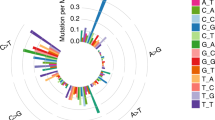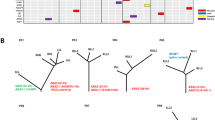Abstract
Homozygous deletions of the tumor suppressor gene p16INK4A and deficiency of methylthioadenosine phosphorylase (MTAP), both located on chromosome 9p21, have been independently reported in non-small cell lung cancer (NSCLC). To determine the frequency of co-deletion of these two genes, we investigated 50 samples of primary NSCLC using a quantitative PCR-ELISA. All specimens were fixed in formalin, paraffin embedded and stored until assayed. Histologic subtypes included 25 adenocarcinomas (50%), 21 squamous cell carcinomas (42%) and four large cell carcinomas (8%). Homozygous deletions of MTAP exon 8 could be detected in 19 of 50 NSCLC samples (38%). Adenocarcinoma (11 of 25, 44%) showed a higher deletion frequency than squamous cell carcinoma (six of 21, 29%). In contrast, homozygous p16INK4A deletions were detected in only nine of 50 (18%) samples using specific primers for p16INK4A exon 1α. No difference between the histological subtypes and p16INK4A deletion frequency was observed. We further investigated the ten samples with MTAP deletions but intact p16INK4A exon 1α with primers specific for p16INK4A exon 3, the exon nearest to MTAP exon 8. Interestingly, none of the ten samples had deletion of the p16INK4A exon 3 coding region. Fine mapping analysis performed in ten samples showed a frequent breakpoint between MTAP exon 4 and exon 5. In addition, p16 protein expression could not be detected in five out of six samples with intact p16 but deleted MTAP locus. These data show a high frequency of homozygous MTAP deletions in NSCLC which is associated with detectable co-deletion of p16INK4A in only half of the cases. This result suggests the existence either of another tumor suppressor gene telomeric of p16INK4A or of deletions involving 3′-untranslated (3′-UTR) regulatory regions of p16INK4A that can interfere with its expression or function.
This is a preview of subscription content, access via your institution
Access options
Subscribe to this journal
Receive 50 print issues and online access
$259.00 per year
only $5.18 per issue
Buy this article
- Purchase on Springer Link
- Instant access to full article PDF
Prices may be subject to local taxes which are calculated during checkout
Similar content being viewed by others
Author information
Authors and Affiliations
Rights and permissions
About this article
Cite this article
Schmid, M., Malicki, D., Nobori, T. et al. Homozygous deletions of methylthioadenosine phosphorylase (MTAP) are more frequent than p16INK4A (CDKN2) homozygous deletions in primary non-small cell lung cancers (NSCLC). Oncogene 17, 2669–2675 (1998). https://doi.org/10.1038/sj.onc.1202205
Received:
Revised:
Accepted:
Published:
Issue Date:
DOI: https://doi.org/10.1038/sj.onc.1202205
Keywords
This article is cited by
-
Synergistic effects of type I PRMT and PARP inhibitors against non-small cell lung cancer cells
Clinical Epigenetics (2021)
-
MTAP-deficiency could predict better treatment response in advanced lung adenocarcinoma patients initially treated with pemetrexed-platinum chemotherapy and bevacizumab
Scientific Reports (2020)
-
Novel insights into mesothelioma biology and implications for therapy
Nature Reviews Cancer (2017)
-
A phase II multicenter study of L-alanosine, a potent inhibitor of adenine biosynthesis, in patients with MTAP-deficient cancer
Investigational New Drugs (2009)
-
Comprehensive analysis of the 9p21 region in neuroblastoma suggests a role for genes mapping to 9p21–23 in the biology of favourable stage 4 tumours
British Journal of Cancer (2004)



